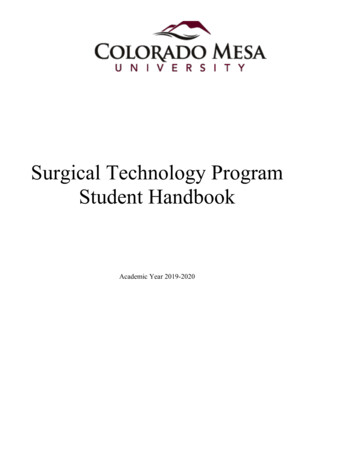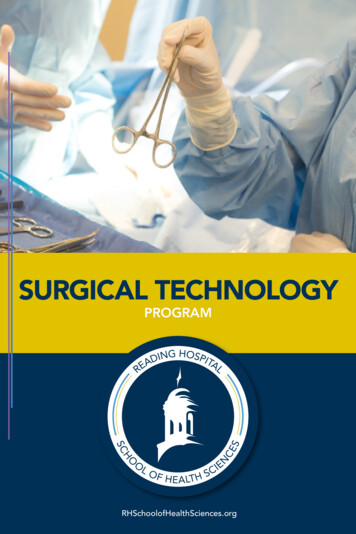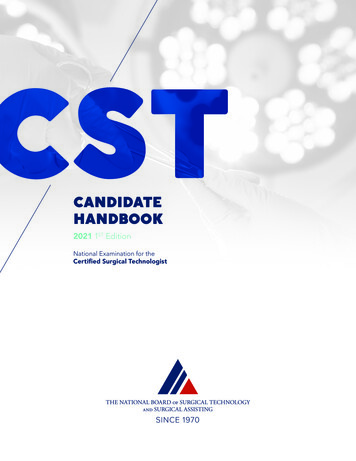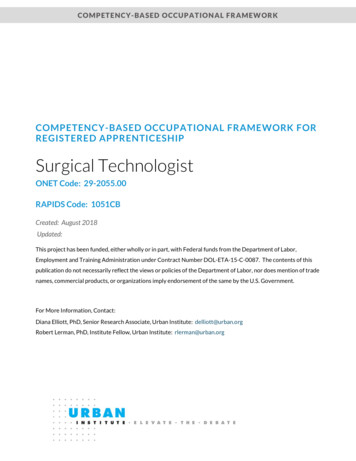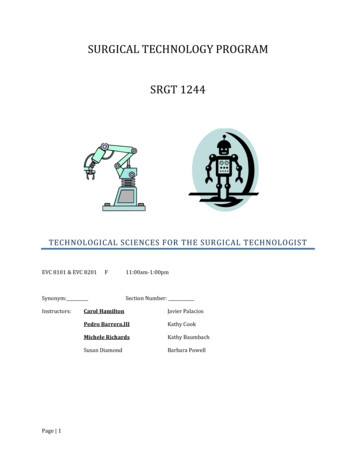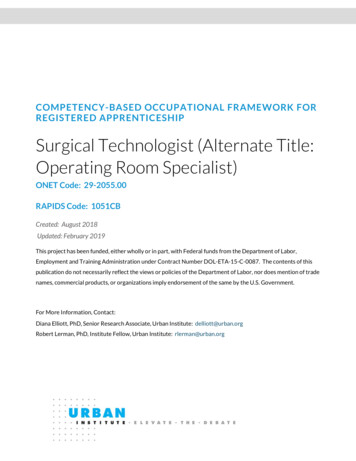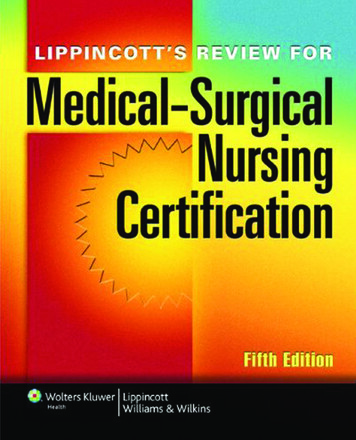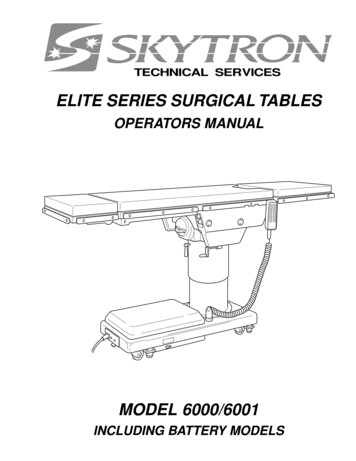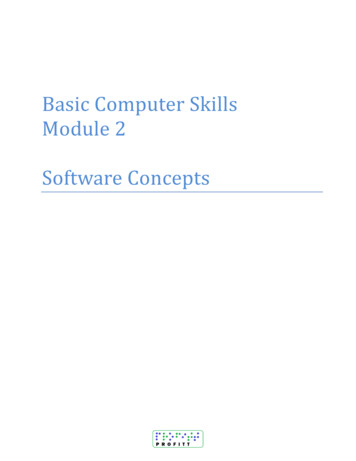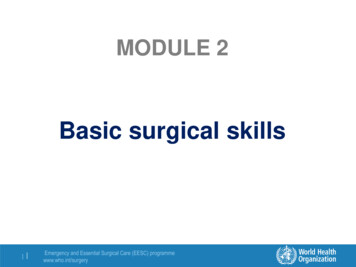
Transcription
MODULE 2Basic surgical skills1 Emergency and Essential Surgical Care (EESC) programmewww.who.int/surgery
OBJECTIVES OF MODULE 2To learn basic surgical techniques––––––2 Surgical scrubbingGowning and gloving for surgeryBasic suturing techniquesTreatment of various woundsAppropriate antibiotic useTreatment of burnsEmergency and Essential Surgical Care (EESC) programmewww.who.int/surgery
ROUTES OF HIV TRANSMISSION Injury with needles or sharp instruments contaminatedwith blood, body fluids Contact between open wounds, broken skin (for example,dermatitis), mucous membranes, and contaminated blood,body fluids Transfusion of infected blood or blood products3 Emergency and Essential Surgical Care (EESC) programmewww.who.int/surgery
PREVENTING TRANSMISSION OFINFECTIONTake care of your patients, your co-workers and yourself: Do not recap needlesSet up sharps containers where sharps are usedDo not use same injection set on more than one patientDispose of your own sharpsPass needles, scalpels, scissors with care and considerationEvery hospital should have clear guidelines for management ofinjury or exposure to infectious materials4 Emergency and Essential Surgical Care (EESC) programmewww.who.int/surgery
INFECTION PREVENTION ANDUNIVERSAL PRECAUTIONS Protect areas of broken skin, open wounds with watertightdressings Treat all body substances of all people as potentiallyinfectious Clean blood spills immediately and safely Asepsis depends on standard procedures, staff training,personal discipline, attention to detail Trauma situations are chaotic, defenses are down, injurieshappen quickly. Precautions are often missed, forgotten,ignored5 Emergency and Essential Surgical Care (EESC) programmewww.who.int/surgery
INFECTION PREVENTION ANDUNIVERSAL PRECAUTIONS Wear gloves during exposure to blood or body fluids, washhands afterwards Wash immediately with soap and water in case of skinexposure, whether from a splash, glove puncture or nongloved contact Wear protective glasses where blood splashes may occur;wash out eyes with water as soon as possible if splashed Wear protective gown or apron if splash potential exists6 Emergency and Essential Surgical Care (EESC) programmewww.who.int/surgery
INFECTION PREVENTION ANDUNIVERSAL PRECAUTIONS Infection is the most important and preventable cause of impairedwound healing Microorganisms can reach tissues during surgery or manipulation ofsurgical wound carried and transmitted by:– People, including patients– Inanimate objects, including instruments, sutures, linen, swabs,solutions, mattresses, blankets– Air around wounds, which can be contaminated by dust anddroplets of moisture from anyone assisting at surgery or caring forwound Aseptic treatment of a wound: an attempt to prevent bacterialcontamination from these sources, during surgery, initial phase ofhealing7 Emergency and Essential Surgical Care (EESC) programmewww.who.int/surgery
OPERATING THEATRE Keep all doors to operating theatre closed except as neededfor passage of equipment, personnel, patients Store some sutures, extra instruments Minimize number of people allowed to enter Keep room uncluttered, easy to clean Between cases, clean and disinfect table, instruments,surfaces8 Emergency and Essential Surgical Care (EESC) programmewww.who.int/surgery
HAND WASHING Hand washing: the single most important measure forprevention of infection Plain soap and water is effective for removal of visiblecontaminants Wash with vigorous mechanical action on all hand surfacesfor at least 40 seconds; washing above wrists, removingjewellery Nails are areas of greatest contamination Rinse under poured or running water9 Emergency and Essential Surgical Care (EESC) programmewww.who.int/surgery
HOW TO HAND WASHTo effectively reduce thegrowth of germs on hands,hand washingmust last 40–60 sand should be performedby following all of theillustrated steps.For further reference on clean carehttp://www.who.int/gpsc/en/10 Emergency and Essential Surgical Care (EESC) programmewww.who.int/surgery
HOW TO HAND RUBTo effectively reduce thegrowth of germs onhands, hand rubbingmust be performed byfollowing all of theillustrated steps.This takes only 20–30seconds!For further reference on clean carehttp://www.who.int/gpsc/en/11 Emergency and Essential Surgical Care (EESC) programmewww.who.int/surgery
SCRUBBING 12 Emergency and Essential Surgical Care (EESC) programmewww.who.int/surgeryRemove jewelleryUse soap, brush,running water to cleanthoroughly around nailsScrub hands, arms up toelbowsAfter scrubbing, hold uparms to allow water todrip off elbowsTurn off tap with elbow
SCRUBBINGAfter scrubbing hands: Dry with sterile towel, make sure towel does not becomecontaminated Hold hands, forearms away from body and higher thanelbows until putting on sterile gown and gloves13 Emergency and Essential Surgical Care (EESC) programmewww.who.int/surgery
GOWNING Place armsthrough sleeves Have a nonscrubbedassistant pullgown overshoulders sohands go throughsleeves Assistant will tieback of gown14 Emergency and Essential Surgical Care (EESC) programmewww.who.int/surgery
GLOVING Surgical gloves prevent transmission of HIV and otherinfections through contact with blood, other body fluids Easiest to have someone who is already gowned and glovedto assist Promptly change a glove punctured during surgery, rinsehand with antiseptic or rescrub15 Emergency and Essential Surgical Care (EESC) programmewww.who.int/surgery
GLOVING without assistance Open sealed package of sterile glovesbefore scrubbing, gowning; placeinner package on sterile surface Once gowned, take cuff of left glovewith right hand (1); make sure thumbin correct position Slide glove onto left hand, wrigglefingers slightly to help Only touch inside of glove, cuff withbare hands Slide fingers of gloved left hand intocuff of right glove (2)16 Emergency and Essential Surgical Care (EESC) programmewww.who.int/surgery
GLOVING Pull glove onto right hand in similarfashion to placing left glove (3) Ensure that cuffs cover ends of bothgown sleeves (4)17 Emergency and Essential Surgical Care (EESC) programmewww.who.int/surgery
INSTRUMENTSMany types of instruments– Forceps, instruments for holding tissue– Needle holders– Scissors– RetractorsWhich instrument to use?– Choose shortest instrument that will comfortably reachoperative site– If cutting suture or non-tissue material, avoid using finescissors– If possible, choose instruments in good repair18 Emergency and Essential Surgical Care (EESC) programmewww.who.int/surgery
INSTRUMENTSWhen holding instruments: Use three point control: have 3points of contact between hand,instrument to increase precision Extend index finger alonginstrument to provide extra control,stability Place only fingertips through handleloops, rotation comes from wrist greater control quicker to pick up, put down19 Emergency and Essential Surgical Care (EESC) programmewww.who.int/surgery
INSTRUMENTS#1020 #11#15When using scalpel for dissection,– use smaller knife– hold instrument like a pen: thumb andthird finger holding knife, with indexfinger controlling dissectionMost procedures are performed with a #3handle and– #10 blade for large incisions– #11 for stab incision– #15 for fine precision workEmergency and Essential Surgical Care (EESC) programmewww.who.int/surgery
SKIN PREPARATION Before operation, wash surgical site, surrounding area withsoap, water; particularly wash debris from injuries Prepare skin with antiseptic solution; start in centre, moveto periphery Chlorhexidine gluconate and iodine preferable to alcohol asless irritating to skin Solution should remain wet on skin for at least two minutes21 Emergency and Essential Surgical Care (EESC) programmewww.who.int/surgery
SKIN PREPARATION Prepare skin withantisepticsolution, start incenter, move toperiphery This area shouldbe large enoughto include entireincision, adjacentworking area22 Emergency and Essential Surgical Care (EESC) programmewww.who.int/surgery
DRAPING Do not place drapes onpatient until scrubbed,gowned, gloved Leave uncovered onlyoperative field (areasthat have been prepped)and areas necessary foranaesthesia Secure drapes withtowel clips at eachcorner23 Emergency and Essential Surgical Care (EESC) programmewww.who.int/surgery
WOUND MANAGEMENTSurgical wound classification: 24 CleanClean Contaminated: normal but colonized tissueContaminated: contains foreign or infected materialInfected: obvious pus presentEmergency and Essential Surgical Care (EESC) programmewww.who.int/surgery
WOUND MANAGEMENT Clean wounds: close immediately to allow healing byprimary intention Contaminated or infected wounds: never close, leave opento heal by secondary intention Clean Contaminated: surgical toilet, leave open, then close48 hours later - delayed primary closure Careless closure of a contaminated wound will promoteinfection and delay healing25 Emergency and Essential Surgical Care (EESC) programmewww.who.int/surgery
WOUND MANAGEMENTPrimary repair: Primary closure requires clean tissue to be approximatedwithout tension Leave skin sutures in place for an average 7 days; longer ifhealing expected to be slow due to blood supply ofparticular location (back or legs) or patient’s condition Close deep wounds in layers; absorbable sutures for deeplayers26 Emergency and Essential Surgical Care (EESC) programmewww.who.int/surgery
WOUND MANAGEMENTDelayed Primary Closure: Irrigate clean contaminated wounds, then pack open withdamp saline gauze Close wounds with sutures at 2 daysSecondary healing: Perform wound toilet, surgical debridement withoutclosure; may need skin graft27 Emergency and Essential Surgical Care (EESC) programmewww.who.int/surgery
WOUND TOILET AND SURGICALDEBRIDEMENT Thoroughly clean the wound with normal saline or sterilewater. It is important to use a large volume of fluid and pressureto remove all visible dirt and debris from a wound Use a large syringe for irrigation. Attach a 16 or 19 gaugeneedle or soft IV catheter to generate pressure.28 Emergency and Essential Surgical Care (EESC) programmewww.who.int/surgery
WOUND TOILET ANDSURGICAL DEBRIDEMENT Gentle handling of tissues to minimize bleeding, additionaltrauma Control residual bleeding with compression, ligation,cautery Dead or devitalized muscle is dark in color, soft, easilydamaged; does not contract when pinched Dead tissue does not bleed when cut29 Emergency and Essential Surgical Care (EESC) programmewww.who.int/surgery
WOUND TOILET ANDSURGICAL DEBRIDEMENTAB30 Wash wound with large quantities ofsoap and boiled water for 10 minutes,then irrigate with saline; prep skinwith antiseptic (A) Debride wound meticulously toremove loose foreign material, usesurgical techniques to cut awaydamaged, dead tissue Excise only very thin margin of skinfrom wound edge (B)Emergency and Essential Surgical Care (EESC) programmewww.who.int/surgery
DEBRIDEMENTCD31 Systematically perform wound toilet,surgical debridement; initially tosuperficial tissue layers, subsequentlydeeper layers (C and D) With scalpel or dissecting scissors,remove all adherent foreign materialalong with a thin margin of underlyingtissue, irrigate Continue cycle of surgicaldebridement, saline irrigation untilwound is completely cleanEmergency and Essential Surgical Care (EESC) programmewww.who.int/surgery
WOUND TOILET AND SURGICALDEBRIDEMENT Leave wound open after debridement to allow for healingby secondary intention Pack lightly with damp saline gauze, cover packed woundwith dry dressing Change packing, dressing daily - more often if outerdressing becomes damp with blood, other body fluids Large defects will require closure with flaps or skin graftsbut may be initially be managed with saline packing32 Emergency and Essential Surgical Care (EESC) programmewww.who.int/surgery
PREVENTION OF WOUND INFECTIONS Restore breathing, blood circulation as soon as possibleafter injury Warm victim; at earliest opportunity provide high-energynutrition, pain relief Perform wound toilet, debridement as soon as possible(within 8 hours if possible) Respect universal precautions Antibiotic prophylaxis for deep or penetrating wounds(dirty stick, knife) and wounds older than 12 hours33 Emergency and Essential Surgical Care (EESC) programmewww.who.int/surgery
PREVENTION OF WOUND INFECTIONSFactors that affect wound healing and infection potentialPatient Age Underlying illnesses or disease: anemia, diabetes, immune deficientWound 34 Organ or tissue injuredExtent of injuryNature of injury (laceration less complicated than crush injury)Contamination or infectionTime between injury and treatment (sooner is better)Emergency and Essential Surgical Care (EESC) programmewww.who.int/surgery
WOUND INFECTIONS IN CHILDRENImmuno-suppression from chronic parasitic infections orunderlying malnutrition greatly affect wound healing and riskof infectionPreventing infection– Cleaning wound: most important factor– Antibiotics usually not necessary unless: Wound older than 12 hours Deep penetrating wounds (dirty stick, knife)35 Emergency and Essential Surgical Care (EESC) programmewww.who.int/surgery
WOUND INFECTIONS IN CHILDRENWound closure Less than 24 hours from injury, cleaned properly:primary closure Greater than 24 hours, contaminated or animal bite: donot close Wounds not closed primarily should be packed lightlywith damp gauze If clean after 48 hours, delayed primary closure If wound infected, pack lightly, heal by secondaryintention36 Emergency and Essential Surgical Care (EESC) programmewww.who.int/surgery
WOUND INFECTIONS IN CHILDREN Clinical signs: Pain, swelling, redness, warmth, pus drainage Treatment Open wound if pus present or suspected Clean with disinfectant Pack lightly with damp gauze, change daily Antibiotics until cellulitis resolved Staphylococcus: Cloxacillin (25-50mg/kg po qid) Suspected bowel flora : Ampicillin (25-50mg/kg po qid),Gentamycin (7.5 mg/kg IM or IV once a day) andMetronidazole (7.5 mg/kg tid)37 Emergency and Essential Surgical Care (EESC) programmewww.who.int/surgery
TETANUS PROPHYLAXISPatient vaccinated: give booster if neededPatient not vaccinated: give antitetanus serum and start doseof tetanus toxoid vaccine (separate syringes, separate sites)Antitetanus serum for adults and childrenTetanus immunoglobulin (human) 250 units IM, increased to500 units if any of the following conditions apply: wound older than 12 hours presence or risk of heavy contamination patient weight more than 90 kg38 Emergency and Essential Surgical Care (EESC) programmewww.who.int/surgery
TETANUS IMMUNIZATIONADULTS and CHILDREN over 7 years: tetanus toxoid (TT) or tetanus and diphtheria vaccine (Td)CHILDREN under 7 years: Diphtheria and tetanus vaccine (DT). Higher diphtheria toxoid contentDose of TTor TdWhen to giveExpected duration ofprotection1As early as possibleNone2At least 4 weeks after TT 11-3 years3At least 6 months after TT 2At least 5 years4At least 1 year after TT 3At least 10 years5At least 1 year after TT 4Booster every 10 yearsModified from index2.html39 Emergency and Essential Surgical Care (EESC) programmewww.who.int/surgery
ANTIBIOTIC PROPHYLAXISIndicated for wounds at high risk for infection:– Contaminated wounds– Penetrating wounds– Abdominal trauma– Compound fractures– Lacerations greater than 5 cm– Wounds with devitalized tissue– High risk anatomical sites—hand, foot40 Emergency and Essential Surgical Care (EESC) programmewww.who.int/surgery
PRACTICAL SUTURE TECHNIQUESVertical mattress sutureInvertedsuture41 Horizontal mattress sutureEmergency and Essential Surgical Care (EESC) programmewww.who.int/surgerySubcuticular sutureRetention suture
SUTURE TECHNIQUES Aim of all suturing techniques: approximate wound edgeswithout gaps or tension Size of suture “bite” and interval between bites should beequal in length, proportional to thickness of tissue beingapproximated Suture is foreign body: use minimal size, amount of suturenecessary to close wound42 Emergency and Essential Surgical Care (EESC) programmewww.who.int/surgery
SUTURE MATERIALSSutures are made of variety of materials with variety ofproperties Non-absorbable– Use when possible– Braided suture not ideal for contaminated wounds– May sterilize polyester thread or nylon line whencommercial suture unavailable Absorbable– Degrades, loses tensile strength within 60 days– Option when not possible for patient to return or forchildren for whom suture removal may be difficult43 Emergency and Essential Surgical Care (EESC) programmewww.who.int/surgery
SUTURE TECHNIQUES Use tip of needle driver to hold needlebetween half - two thirds way along needle Hold needle driver so that fingers are justwithin rings so possible to rotate wrist Pass needle tip through skin at 90o Use curve of needle by turning needlethrough tissue Close deep wounds in layers with eitherabsorbable or monofilament non-absorbablesuturesInverted suture44 Emergency and Essential Surgical Care (EESC) programmewww.who.int/surgery
SUTURE TECHNIQUESInterrupted sutures Most commonly used to repairlacerations Permits good eversion of woundedges Use only when minimal skin tension Ensure bites are equal volume If wound edge is unequal, bring thicker side to meet thinnerside to avoid putting extra tension on thinner side Use non-absorbable suture, if possible45 Emergency and Essential Surgical Care (EESC) programmewww.who.int/surgery
SUTURE TECHNIQUESContinuous/running sutures– Less time-consuming than interrupted sutures;– Fewer knots tied– Less suture material used– Less precise in approximating wound edges– Poorer cosmetic result than other options– Epidermal skin cells growing into wound (inclusion cyst)or along suture track are potential complications46 Emergency and Essential Surgical Care (EESC) programmewww.who.int/surgery
SUTURE TECHNIQUESContinuous subcuticular sutures Excellent cosmetic result Use fine, absorbable braided or monofilamentsuture Does not require removal if absorbable suturesused Useful in wounds with strong skin tension,especially patients prone to keloid formation Anchor suture in wound; from apex, take bitesbelow dermal-epidermal border Start next stitch directly opposite preceding one47 Emergency and Essential Surgical Care (EESC) programmewww.who.int/surgerySubcuticular suture
SUTURE TECHNIQUESMattress sutures– Provides relief of wound tension– Provides precise wound edge apposition– More complex, therefore more time-consuming– Vertical and horizontal typesHorizontal mattress suture48 Emergency and Essential Surgical Care (EESC) programmewww.who.int/surgeryVertical mattress suture
SUTURE TECHNIQUESPurse string suture– Circular pattern thatdraws together tissue inpath of suture– Used particularly arounddrain sites– Generally nonabsorbable suture49 Emergency and Essential Surgical Care (EESC) programmewww.who.int/surgery
RETENTION SUTURE TECHNIQUESA.B.Insert retention sutures through entire thickness of abdominalwall leaving them untied (A)Simple or mattress suturesClose wound in layers (B)When skin closure completed, tie each retention suture afterthreading through short length plastic or rubber tubing (C, D)Do not tie retention sutures under tensionLeave sutures in minimum 14 days; may be left for weeks50 Emergency and Essential Surgical Care (EESC) programmewww.who.int/surgeryC.D.
SPECIFIC LACERATIONS: LipInitial stitch at border51 Repair in layers:mucosa, muscleEmergency and Essential Surgical Care (EESC) programmewww.who.int/surgerySuture skin last
SPECIFIC LACERATION: TongueSuture flap-type wounds with absorbable suture52 Emergency and Essential Surgical Care (EESC) programmewww.who.int/surgery
SPECIFIC LACERATIONS: Ear Use folds of ear as landmarks Use absorbable suture for cartilage Support pinna on both sides with gauze53 Emergency and Essential Surgical Care (EESC) programmewww.who.int/surgery
SPECIFIC LACERATIONS: EyelidInitial suture for precise alignment54 Emergency and Essential Surgical Care (EESC) programmewww.who.int/surgeryClosure in layers: absorbable suture
HAND: Treatment of Lacerations Check circulation, sensation, motor function Gently examine wound using aseptic technique todetermine if clean or contaminated: contaminatedwound contains foreign material, crushed or deadtissue Debride, lavage all wounds in operating theatre oremergency area Administer tetanus toxoid, antibiotics if indicated55 Emergency and Essential Surgical Care (EESC) programmewww.who.int/surgery
HAND: Treatment of Lacerations Stop bleeding by compression with sterile gauze; ifnecessary, extend wound, being careful not to cross skincreases in palm, digits Do not excise any skin unless it is dead Close wounds only when clean, using suture, spontaneoushealing or skin grafts If contaminated, delay closure until after seconddebridement Wounds 1 cm will granulate spontaneously56 Emergency and Essential Surgical Care (EESC) programmewww.who.int/surgery
HAND: LacerationsB Cover with sterile gauze (A) Apply plaster splint to hold wristin 20o extension, fingertipsexposed Elevate limb for first week toreduce oedema (B) Begin active exercises as soonas possible Inspect wound in 2-3 days toremove drainsA57 Emergency and Essential Surgical Care (EESC) programmewww.who.int/surgery
SPECIFIC LACERATIONS: Tendons58 Emergency and Essential Surgical Care (EESC) programmewww.who.int/surgery
FOREIGN BODY REMOVAL Timing– Urgent: airway compromise– Unnecessary: some deep metal fragments May be difficult or time-consuming; patient should beanaesthetized X-ray or fluoroscopy is recommended for removal ofradiopaque objects: pins, needles, glass Foreign bodies in cranium, chest, abdomen, close proximityto vital structures must be removed in operating theatrewith team prepared to manage possible complications59 Emergency and Essential Surgical Care (EESC) programmewww.who.int/surgery
FOREIGN BODIES: EARTry irrigation unlesscontraindicatedGentle suctionGentle hook extraction60 Emergency and Essential Surgical Care (EESC) programmewww.who.int/surgery
FOREIGN BODIESEye– Sterile saline wash– Refer if imbedded in eyeNose– Similar to earAirway– Heimlich maneuver– BronchoscopyGI tract– Most pass if smooth– Refer if sharp or obstruction61 Emergency and Essential Surgical Care (EESC) programmewww.who.int/surgeryHeimlich maneuver
62 Emergency and Essential Surgical Care (EESC) programmewww.who.int/surgery
BURN FIRST AID Stop burning process by removing clothing, irrigating burns Use cool running water to reduce temperature of burn Extinguish flames by allowing patient to roll on ground, byapplying a blanket, by using water or other fireextinguishing liquids In chemical burns, remove or dilute chemical agent byirrigating with large volumes of water Wrap patient in clean cloth or sheet, transport to nearestappropriate medical facility63 Emergency and Essential Surgical Care (EESC) programmewww.who.int/surgery
BURN FIRST AID Do not start first aid before ensuring your own safety(switch off electricity, wear gloves for chemicals, etc.) Do not apply paste, oil, turmeric or raw cotton to burn Do not apply ice, may deepen injury Avoid prolonged cooling with water, will lead tohypothermia Do not open blisters until topical antimicrobials can beapplied at health care facility Avoid application of topical medication until patient hasbeen placed under appropriate medical care64 Emergency and Essential Surgical Care (EESC) programmewww.who.int/surgery
ACUTE BURN MANAGEMENT 65 Stop the burningABCDE'sDetermine percentage area of burnGood IV access, early fluid replacementAdequate pain control essentialSeverity of burn determined by:– Burned surface area– Depth of burn– Other considerationsEmergency and Essential Surgical Care (EESC) programmewww.who.int/surgery
ACUTE BURNS 1st degree: superficial epidermis and upper dermis 2nd degree: partial thickness1 Superficial partial thickness (S) 2S Deep partial thickness (P)- Penetrates deep in dermis- Skin grafting recommended 3rd degree: full-thickness Destroy all epidermal anddermal elements Always use skin grafts Most are mixed depth66 Emergency and Essential Surgical Care (EESC) programmewww.who.int/surgery2P3
ACUTE BURN MANAGEMENTAirway: beware of inhalation, rapid airway compromiseBreathingCirculation: fluid replacementDisability: compartment syndromeExposure: percentage area of burnMorbidity and mortality rises with increased burn surfacearea or with increased age; even small burns may be fatal inelderly67 Emergency and Essential Surgical Care (EESC) programmewww.who.int/surgery
ACUTE BURNSDepth of BurnCharacteristicsCauseFirst degree ErythemaPainAbsence of blistersSecond degree- superficial partialthickness Red or mottled Flash burnsBlisterspainfulPaleReduced sensationWith or without blistersDark and leathery Dry Second degree- deep partial thicknessThird degree – fullthickness68 Emergency and Essential Surgical Care (EESC) programmewww.who.int/surgery SunburnContact with hot liquidsFireElectricity or lightningProlonged exposure tohot liquids/objects
ESTIMATION OF BURN AREA:Rule of 9's Count non-superficial burns(2nd degree and 3rd degree) The patient’s hand isapproximately 1% of bodysurface area.69 Emergency and Essential Surgical Care (EESC) programmewww.who.int/surgery
ESTIMATION OF BURN AREA:CHILDRENAreaBy Age in Years0Head (A/D) 10%Thigh (B/E) 3%Leg (C/F)2%70 Emergency and Essential Surgical Care (EESC) programmewww.who.int/surgery15109%3%3%7%4%3%6%5%3%
FLUID RESUSCITATIONNecessary for burns 15% of total body surface area (TBSA) in adults 10% of total body surface in children Use Ringer’s lactate or normal salineThe fluid requirement for the first 24h can be calculated2 - 4 mlxbody weight in kgx%TBSA Give half in the first 8h and remainder in the next 16h Children also need maintenance fluids with glucose Monitor urine output and adjust iv fluids71 Emergency and Essential Surgical Care (EESC) programmewww.who.int/surgery
ACUTE BURN MANAGEMENT Focus care on rapid healing, infection prevention– If small area: immerse in cold water 30 minutes toreduce oedema, tissue damage Tetanus toxoid Remove broken, tense or infected blisters Excise adherent necrotic tissue Gently cleanse burn with 0.25% (2.5 g/l) chlorhexidinesolution, 0.1% (1 g/l) cetrimide solution, or another mildwater-based antiseptic Maintain good nutrition: very high metabolic demands dueto burns72 Emergency and Essential Surgical Care (EESC) programmewww.who.int/surgery
ACUTE BURN MANAGEMENT Change burn dressing daily or as often as necessary toprevent seepage through dressing On each dressing change, remove any loose tissue Inspect wounds: discoloration, hemorrhage may indicatedeveloping infection. Cellulitis in surrounding tissue is an indicator of infection Fever is not a useful sign; may persist until burn healed73 Emergency and Essential Surgical Care (EESC) programmewww.who.int/surgery
ACUTE BURN MANAGEMENT Administer topical antibiotic chemotherapy daily: Silvernitrate (0.5% aqueous) cheapest, apply with occlusivedressings, does not penetrate eschar Use silver sulfadiazine (1% miscible ointment) with singlelayer dressing; has limited eschar penetration, may causeneutropenia Mafenide acetate (11% miscible ointment) used withoutdressings; penetrates eschar but causes acidosis Alternating these agents is an appropriate strategy74 Emergency and Essential Surgical Care (EESC) programmewww.who.int/surgery
ACUTE BURN MANAGEMENTSerious burn requiring hospitalization: Greater than 15% burns in adult Greater than 10% burns in child Any burn in very young, elderly, infirm Full thickness burns Burns of special regions: face, hands, feet, perineum Circumferential burns Inhalation injury Associated trauma or significant pre-burn illness: e.g.diabetes75 Emergency and Essential Surgical Care (EESC) programmewww.who.int/surgery
ACUTE BURN MANAGEMENT Treat burned hands with special care to preserve function Cover hands with silver sulfadiazine, place in loosepolythene gloves or bags secured at wrist Elevate hands first 48 hours, then start hand exercises At least once a day, remove gloves, bathe hands, inspectburn, reapply silver sulfadiazine, gloves If skin grafting necessary, consider treatment by specialistafter healthy granulation tissue appears76 Emergency and Essential Surgical Care (EESC) programmewww.who.int/surgery
ACUTE BURN MANAGEMENT:Healing phase Burn depth and surface involved influence duration ofhealing phase Without infection, superficial burns heal rapidly Apply split thickness skin grafts to full-thickness burns afterwound excision or appearance of healthy granulation tissue Plan to provide long term care to patient Burn scars undergo maturation– First red, raised, uncomfortable– Frequently become hypertrophic, form keloids,– Although soften, fade with time; can take up to twoyears77 Emergency and Essential Surgical Care (EESC) programmewww.who.int/surgery
ACUTE BURN MANAGEMENT: Nutrition Energy, protein requirements extremely high due to thecatabolism of trauma, heat loss, infection, demands oftissue regeneration If necessary, feed patient through nasogastric tube toensure adequate energy intake Anemia and malnutrition prevent burn wound healing,result in failure of skin grafts Eggs, peanut oil are good, locally available supplements78 Emergency and Essential Surgical Care (EESC) programmewww.who.int/surgery
ACUTE BURN MANA
Take care of your patients, your co-workers and yourself: Do not recap needles Set up sharps containers where sharps are used Do not use same injection set on more than one patient Dispose of your own sharps Pass needles, scalpe
